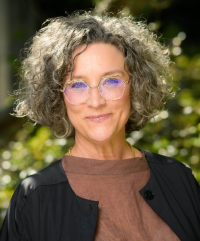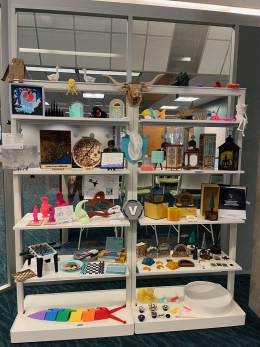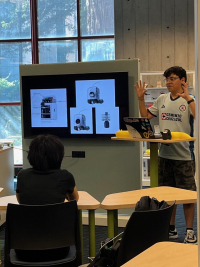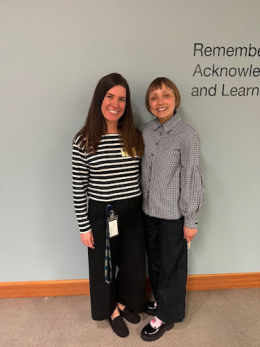
News from University Librarian Elizabeth Cowell
The Library’s contributions to teaching and curricula
Center for Archival Research and Training celebrates 10 years of success
Inaugural Full-Year Graduate Fellowship
A Bestiary: Critters, Myths, and Monsters of UCSC Special Collections & Archives!
Latest acquisition: The Smoke Inside
Congratulations to Our Outstanding Staff!
News from University Librarian Elizabeth Cowell
Dear Friends,
This fall quarter, we are so excited to welcome both new and returning UC Santa Cruz community members to the University Library! Many people do not realize the breadth of all that the library has to offer. From author support to experiential learning opportunities, we are here to support students, staff, and faculty in their academic endeavors.

The Learning, Research, & Engagement team is here to support students and faculty by developing information literacy skills, promoting best practices in scholarly communication, and integrating library collections into assignments and research projects. The University Library Center for Digital Scholarship works with faculty across campus, including such areas as music, digital new media, Latin American media theory, and computer science and engineering—to name a few! In this newsletter, you will read about the opportunities that student workers in the Digital Scholarship Innovation Studio have to support and teach their peers.
Special Collections & Archives at the library also contributes to student success, largely through hands-on experiential learning with primary sources. Sam Regal, the Instruction & Exhibitions Librarian, works with faculty to pull unique materials that will be of interest to their students, who then visit SC&A. Sam is also responsible for curating the current exhibition in SC&A: Bestiary. We hope you will stop by for a visit!
Speaking of experiential learning, we are proud to share with you that the Elisabeth Remak-Honnef Center for Archival Research and Training (CART) is celebrating its 10th anniversary this month! Over its ten years, the CART program has had an impact on student success, in providing a structured learning, research, and career development experience for graduate students. CART has trained over 40 graduate students, primarily PhD candidates from the Humanities, Arts, and Social Sciences divisions. Participants gain direct experience in archival processing, curation, and research, skills that are highly valued in a range of professional fields.
Last academic year, CART offered its first ever full-year fellowship to PhD candidate, Meleia Simon-Reynolds. By supporting one student for an entire academic year with tuition and fees covered, CART is able to provide the fellow with more in-depth involvement. Meleia processed two archival collections, organized and hosted three public programs, and curated an exhibition.
This newsletter only scratches the surface of all that the library has to offer. I encourage you to explore our website, library.ucsc.edu, to learn more about academic research help, teaching support, and University Library news and events.
Elizabeth
The Library’s contributions to teaching and curricula
By Liz White
Librarians at UC Santa Cruz continually employ listening tours and assessment techniques to better understand the student experience and refine their instructional methods. They model effective research procedures, teach new technology, and demystify hidden curricula with the goal of helping both undergraduate and graduate students build strong skills and connections throughout their academic journey.

The library's Learning, Research, & Engagement team fosters a sense of community for undergraduates, graduate students, and faculty. This past year, Arts & Humanities Librarian Annette Marines assessed her instructional methods and explored the method of “flipped learning”. Flipped learning, or placing the emphasis on the learner rather than the teacher, has resulted in students better understanding library research practices and rethinking how they frame their research questions.
Science Librarian Christy Caldwell provides instructors in the Physical & Biological Sciences division with curricular support. She does so by first understanding their learning goals then choosing a plan that addresses these goals, while also considering how to create an inclusive and equitable learning environment for students. In order to improve the instructional outcomes for the undergraduate students with whom she works, Christy created a unique rubric to gauge their understanding of sources and citations, assessing such questions as “are students finding sources relevant to their information needs?” and “are students citing a variety of formats?” Her assessment findings will shape how she leads instruction this year.
The University Library Center for Digital Scholarship team includes Steph Layton and Daniel Story, Digital Scholarship Librarians. Recently, Steph and members of the Digital Scholarship Innovation Studio team worked with students of a music class to design and build musical instruments, which they then used for subsequent assignments. In the David Kirk Digital Scholarship Commons, Daniel worked with a Latin American and Latino Studies class to understand the history of forced migration using Geographic Information System integration to map data.

Sam Regal, Instruction & Exhibitions Librarian, welcomes students and faculty to Special Collections & Archives so that they can experience hands-on learning with primary sources, such as centuries-old historical texts and unique artist-made books. New and returning students can become familiar with the resources available to them, taking inspiration for their own research and artist creations.
Sheila García Mazari, the Online Learning Librarian, meets students where they are: online! Now more than ever, the online space serves as an extension of the library’s physical environment and is designed to meet the evolving needs of the campus community. In her work, Sheila emphasizes the importance of fostering a sense of belonging by valuing students' knowledge and experiences. Her goal is to highlight information literacy as a life skill, empowering students to see themselves as active participants in the scholarly conversation.
Spotlight on Digital Scholarship Innovation Studio (DSI) Student Workers: A Glimpse into Their Journey and Career Inspirations
By Liz White
Meet Jerrott and Chris, two dedicated student workers at the Digital Scholarship Innovation Studio (DSI) who bring unique perspectives and experiences to the team.

Jerrott, a recent business management and economics graduate from the class of 2024, has been with the DSI for two years. His passion for building and creating began in high school as a mechanical lead on a robotics team, and working at the DSI feels like a natural extension of his hobbies. "It’s like being paid to do a hobby," he says, reflecting on how the role has fueled his creativity and hands-on skills.
Chris, a cognitive science major with a minor in computer science, is in his fourth year and expects to graduate in 2026. Though he did not come to the DSI with prior maker space experience, his fascination with technology and 3D printing quickly grew. For Chris, the opportunity to explore new skills and the vast possibilities within 3D design has been fun and eye-opening.

Both Jerrott and Chris agree that working at the DSI has influenced their future plans. Chris remains deeply interested in computers and artificial intelligence, and his new 3D
modeling and machine maintenance skills have broadened his technical horizons. Meanwhile, Jerrott sees the job as a stepping stone toward his entrepreneurial aspirations, particularly in the realm of small business and product creation. Through teamwork, leadership, and hands-on learning, both students are shaping their academic and career goals—one 3D print at a time.
Impact on the Classroom: Expanding the DSI's Reach
Jerrott and Chris also support students across multiple disciplines through their work with DSI, helping bridge the gap between technology and creativity. A major part of their role is working with students in the popular CSE3 class, an introductory computer science course. Jerrott notes that students from all backgrounds—psychology, communications, and beyond—come to workshops to learn how to use tools like the laser cutter, 3D printer, and vinyl cutter. "It puts the space on the map for people who might not be in engineering," Jerrott says, highlighting how the DSI opens up opportunities for a diverse group of students.
Chris shares a similar sentiment, recalling how he started as a CSE3 student and was initially intimidated by the machines. Now, he finds joy in teaching others, especially when working with students who might be hesitant or unfamiliar with the equipment. “I like to make sure everyone feels confident and safe," he says, emphasizing that every student should have the chance to explore and learn in the space.
For both Jerrott and Chris, teaching others provides a way to give back and an opportunity to refine their own skills. As Jerrott puts it, “Their questions really make us think, understand, and refine the way we’re teaching things.”
Favorite Tools of the Trade

When asked about their favorite pieces of equipment, Jerrott and Chris have clear favorites. For Chris, it's the 3D printers—despite initial intimidation, he’s now confident in training others. "I wanted that same connection with the printers that Jerrott has with the laser cutter," he explains. Jerrott, on the other hand, prefers the laser cutter for its creative potential. "It’s cool to bring out that artistic side, seeing a project through from idea to prototype to finished product," he shares.
Both students also enjoy the sense of community that comes with working at the DSI, as they see regular visitors who contribute to the space and exchange ideas. Whether it’s helping a student refine a 3D print design or working alongside faculty to build out course content, Jerrott and Chris appreciate how their work fosters collaboration and learning.
Memorable Moments in the DSI
Jerrott and Chris have both had moments at the DSI that left lasting impressions. Chris recalls helping a graduate student, new to 3D printing, refine his designs over time for an environmental studies project. “He always comes back, closer and closer to that final design,” Chris says, noting how rewarding it is to see students' progress. Jerrott has similarly fond memories of working with a grad student who went from being a beginner to confidently using the 3D printer. Says Jerrott: “We facilitate that type of learning in the DSI: it’s ok to make mistakes.” He also helped a professor build out a laser-cutting curriculum for the CSE3 class, which includes fun projects like creating custom designs or turning photos into puzzles.
The Most Rewarding Part of the Job: Growth & Building Community

For both Jerrott and Chris, the most rewarding aspect of their work at the DSI is the sense of community. Chris enjoys creating an inviting atmosphere where students feel comfortable asking questions and learning new skills. "The most rewarding part is just having people here," he says, underscoring the importance of making the space welcoming.
Jerrott echoes these sentiments, adding that personal growth has been a huge benefit of working in such a supportive environment. “I’m picking up all these skills—whether it’s using Adobe or 3D modeling software—in a low-stakes environment where it’s ok to make mistakes,” he says. "Every time you make mistakes, you’re also learning from them."
As both Jerrott and Chris continue their journeys at the DSI, their passion for helping others and fostering a creative, collaborative environment will undoubtedly continue to shape the space and those who walk through its doors.
Center for Archival Research and Training celebrates 10 years of success
By Abby Butler
This October, the University Library at UC Santa Cruz Elisabeth Remak-Honnef Center for Archival Research and Training (CART) marks its 10th anniversary, celebrating a decade of shaping graduate students’ careers through hands-on archival experience.

Since its founding in 2014, CART has become a cornerstone for students seeking practical skills in archival research, benefiting both their professional growth and the university’s renowned collections. By offering hands-on learning opportunities, CART equips graduate students with the expertise needed for career success while also making valuable library resources more accessible.
“Over its ten years, the CART program has had an impact on student success, in providing a structured learning, research, and career development experience for graduate students,” says Elizabeth Cowell, Richard L. Press University Librarian, Presidential Chair. “CART also benefits our greater community, by making the collections in our care accessible and discoverable for all to use in researching their histories and creating new knowledge.”
To honor this milestone, CART will host a mini-symposium on Oct. 1 featuring alumni of the program who have built successful careers in academia, archives, and beyond. These former fellows will share how CART shaped their professional journeys and opened doors to diverse career paths.
Building Careers Through Archival Work

CART has trained over 40 graduate students, primarily PhD candidates from the humanities, arts, and social sciences divisions. Participants gain direct experience in archival processing, curation, and research, skills that are highly valued in a range of professional fields.
“Working with students from various disciplines has been incredibly rewarding,” says Alix Norton, Archivist for the Center for Archival Research and Training since 2015. “They not only enhance their research skills but also discover new career opportunities, whether in libraries, academia, or beyond.”
Many CART alumni have secured prestigious career positions, including at institutions like the Smithsonian, while others have pursued advanced degrees in library science, solidifying their expertise in the archival field.
Evolving Program Models for the Future
What started as a pilot program, hiring students for 10 hours per week during a single quarter, has evolved significantly. In the 2023-2024 academic year, CART launched a fully funded fellowship, supporting one student for an entire academic year with tuition and fees covered. This model allows for more in-depth involvement, as fellows work closely with archivists and other library staff to process collections and curate exhibits for the public.
The inaugural full-year CART fellow was Meleia Simon-Reynolds, a PhD candidate in history and co-director of the Watsonville is in the Heart (WIITH) Digital Archive. She processed two archival collections, including the records of the Watsonville-Santa Cruz chapter of the Japanese American Citizens League, curated two public exhibits, and planned multiple events to increase engagement with archival materials.
“This fellowship model has been incredibly successful, and we’re excited to continue it this year,” said Norton. “Our 2024-2025 fellow Annika Berry is pursuing her PhD in literature, and will be working on the papers of Donna Haraway. It’s a great opportunity for a student to delve into the work of a renowned scholar who continues to have a huge influence at UC Santa Cruz and globally.”
Showcasing Unique Collections
CART fellows play a key role in processing important archival collections, including the Hayden White papers, Lick Observatory records, and the Yamashita Family papers. The Hayden White collection, which included both physical and digital files, marked CART’s first foray into archiving email correspondence—a groundbreaking experience for students and the Library.
Other collections, such as the early 20th-century photographs and other records from Lick Observatory, offer a glimpse into the development of astronomy at the University of California, while the Yamashita family papers, safeguarded and donated by UC Santa Cruz professor emerita Karen Tei Yamashita, provide a deeply personal view of Japanese American history, spanning generations before, during, and after World War II.
Expanding Reach and New Collaboration
As CART enters its second decade, it is poised to expand its reach even further. One exciting new initiative is part of a broader collaboration between the campus and the Dolores Huerta Foundation. This project, in partnership with UC Santa Cruz’s Latin American and Latino Studies department, the Dolores Huerta Research Center for the Americas, and the Humanities Institute, will include training of two graduate students in archival practice through CART. The students will then travel to Bakersfield during spring break to work alongside a professional archivist on the personal papers of civil rights leader Dolores Huerta, as well as the Foundation's records. The project represents a growing commitment to social justice and community engagement, and CART’s role in offering students invaluable experience in archival research.
“We’re thrilled to be broadening our impact,” said Norton. “Participating in collaborations like this allows us to offer students even more opportunities for meaningful work, and we’re eager to see where these partnerships take us.”
As CART looks toward the future, its commitment to training the next generation of archivists and scholars remains strong. The recent mini-symposium celebrated CART’s past successes but also charted a course for the program’s continued growth.
You can learn more about the Center for Archival Research and Training or make a gift to support the program via the CART website.
Inaugural Full-Year Graduate Fellowship
"[The CART Fellowship was] truly one of the most exciting experiences I've had so far in grad school."
— Meleia Simon-Reynolds, 2023-2024 Fellow

During the 2023-2024 academic year, the Center for Archival Research and Training (CART) offered its first-ever full-year fellowship to Meleia Simon-Reynolds, a PhD candidate in the History Department and the co-director of the Watsonville is in the Heart (WIITH) Digital Archive. Meleia processed two archival collections, the Watsonville-Santa Cruz Chapter of the Japanese American Citizens League records and the Nina Graboi Papers, organized and hosted three public programs, and curated the exhibition Remember, Acknowledge, and Learn: Engaging with the Watsonville-Santa Cruz Japanese American Citizens League Collection (on view now through December 6 at McHenry Library).

As part of her work on the Watsonville-Santa Cruz Chapter of the Japanese American Citizens League (JACL) records and the exhibition, Meleia hosted a community-focused event at JACL’s Kizuka Hall in Watsonville, where she elicited feedback and additional descriptions about the Watsonville-Santa Cruz JACL records. Information from that event was added to the collection guide, and partnerships with the community were strengthened. Meleia also presented a research poster on her community engagement work with the Watsonville-Santa Cruz chapter of the JACL at the UCSC Graduate Research Symposium, as well as the 2024 Rare Books and Manuscripts Conference.
On view now:
A Bestiary: Critters, Myths, and Monsters of UCSC Special Collections & Archives!

Medieval bestiaries (Latin: liber beastiarium) are compendiums of animals, birds, fish, reptiles, and fabulous and ferocious chimeric creatures. These texts, developed from the Physiologus of Late Antiquity, were particularly popular in England and France in the 12th century. Bestiaries were not necessarily intended to provide factual information about natural history, but rather to imbue the curious and compelling natural world with a religious moral grounding. Some animals in bestiaries evaded such moralizing, inviting medieval readers to draw their own wide-ranging social, political, and religious connections.
UCSC Special Collections & Archives is positively replete with critters large and small, winged and maned, familiar and exotic, actual and imaginary. This exhibition celebrates a broad range of (mostly) bibliographic materials that engage with the bestiary tradition, explicitly and implicitly. We invite you to explore and discover the many articulations of animalia that populate our collections, to trace the histories these creatures contain, carry, and transmit. Visit Special Collections & Archives on the third floor of McHenry Library to view this special exhibition!
Latest acquisition: The Smoke Inside

Special Collections & Archives at the library supports students and faculty by providing a welcoming space and primary sources for hands-on learning. Sam Regal, the Instruction & Exhibitions Librarian, works with faculty to pull unique materials that will be of interest to their students, who then visit SC&A. One recent acquisition for such use is The Smoke Inside by Roger Peet (2024). The Smoke Inside features the text of interviews with three formerly incarcerated wildland firefighters hand-carved into linoleum and printed with handmade ink made from charcoal gathered in the scars of the 2020 Oregon wildfires.
“Beyond its self-evident value as an art object, The Smoke Inside will also facilitate deep experiential learning. The work generates a perceptible aroma, transforming the instructional space by activating the senses. The ink used in its printing was made with charcoal gathered from the 2020 Oregon wildfires, and it sets the reader in place and situation by generating affective connections to all-too-familiar environmental circumstances. Its evocative hand-carved linoleum prints will also doubtlessly serve as inspiration for student artists and art historians, and its documentation of the experience of incarcerated firefighters will be of interest to students invested in issues of carceral justice.” —Sam Regal
The Smoke Inside was purchased with a generous donation from the UC Santa Cruz Collectors Club, a group of supporters dedicated to growing the holdings of Special Collections & Archives at the Library.
Congratulations to Our Outstanding Staff!
The American Printing History Association has announced that Sam Regal, a fantastic staff member and accomplished librarian and writer specializing in rare books and visual culture, will be the new editor of Printing History, beginning with the Winter 2025 issue. Congrats, Sam!
Dr. Rebecca Hernandez, the community archivist at the UCSC University Library, has recently been appointed as the Watsonville Film Festival board president, furthering her dedication to preserving and celebrating local culture.
Credits
Contributors: Elizabeth Cowell, Liz White, Alix Norton, Sam Regal, and Abby Butler
Production: Linda Hunt
Copyediting: Greg Careaga
Photography: Carolyn Lagattuta, Linda Hunt, Sam Regal, Liz White, Alix Norton, Elena Zhukova and Nick Gonzales


 Santa Cruz, CA
Santa Cruz, CA



